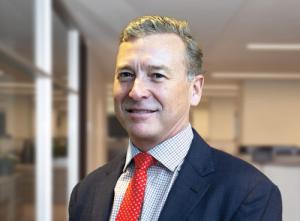Guggenheim Securities
Jim Schaefer is Senior Managing Director, Head of Energy Investment Banking at Guggenheim Securities. Paul Kjellander is PUF Senior Advisor and former Idaho PUC Chair.
Wildfires, unfortunately, are increasingly becoming an issue for energy and utilities companies. Guggenheim Securities' Jim Schaefer and PG&E's Mark Quinlan shared wisdom on these difficult issues.

PUF's Paul Kjellander: Catastrophic wildfires are a major concern for many utilities across the nation. How does the investment community respond to risks utilities are exposed to?
Jim Schaefer: First, we've had a series of unprecedented wildfire events. During the last decade in particular, a number of catastrophic events have taken place in areas that had not been subject to wildfires previously. The number of events, the magnitude of impacts on local communities, and the degree to which utilities are now being blamed for and subject to liabilities are new to investors.
Second, in response to these events, utilities are actively developing, deploying, and measuring services and technologies that can help prevent wildfires and also reduce risks. As a result, the investor community now understands the risks and is focused more on what utilities are doing to address those risks.
The third area, and probably the most important one longer term, is that investors are focused on whether a long-term solution can be implemented to limit liabilities around wildfires. One pathway may involve limited liabilities at the state and/or federal levels.
Another pathway may involve the creation of federal, regional or state wildfire funds that create a buffer zone around utilities. For example, the State of California has taken a big step in creating a wildfire fund, which Guggenheim helped arrange.
We advised the governor's office around the PG&E bankruptcy and took the lead in establishing the fund. The risk exposures are serious in investors' minds, and they are looking for steps to be taken both within utilities and outside utilities to help address them.
PUF: What do utilities need to do to demonstrate to the investment community that they are appropriately addressing the risk?
Jim Schaefer: I see tremendous coordination amongst utilities in sharing information around what they each perceive to be best practices and the steps that need to be taken in their respective jurisdictions to ensure wildfire risks are mitigated. Some of these steps include significant capital expenditure plans to help those best practices move from concept to implementation.
Additionally, utilities need to continue communicating their progress to customer bases, regulators, politicians, investors, and rating agencies.
Time is of the essence. There are many technology and service breakthroughs. Examples include transmission/distribution and monitoring upgrades, pole replacement, undergrounding power lines in certain locations, and real-time dropped line monitoring.
These measures go hand-in-hand with sensible Public Safety Power Shutoff (PSPS) plans that involve communicating to customers the risks and mitigation strategies. Customers will need to understand and prepare for when there's high wildfire risk, high wind, and storms, that unfortunately may result in power needing to be shut down.
PUF: In terms of hardening systems for resiliency, when there's pressure on utilities to get capital for the energy transition, does wildfire mitigation take precedence? Can both be done?
Jim Schaefer: To harden the grid, but also to provide one hundred percent clean electrons, it's going to be expensive, and I believe that the public has yet to fully realize the costs. But the long-term cost of not having a hardened grid and a clean grid is going to be far more expensive.
We cannot have utilities with unlimited liability exposure to wildfire events. It is critical that utilities have abundant access to low-cost capital to fund the reconstruction of the grid.
On the energy transition side, to have clean power, especially clean baseload power, new technologies are needed including new nuclear, hydrogen, carbon capture and sequestration, as well as direct air capture. While these technologies carry initial startup costs and risk, once established the capital costs will come down and allow for abundant opportunities to invest in these critical technologies.
Education around these issues is key in order to obtain customer buy-in, commission support, and political direction.
PUF: What about the legal structure as it relates to catastrophic wildfire and what might be some avenues to consider looking at?
Jim Schaefer: Let me be blunt — we must have liability caps. It may seem to be unachievable to change state and/or federal laws, but utilities' exposure to these liabilities must be capped. Already, customers are being impacted by legal costs associated with wildfires. Unless reasonable limits are placed on wildfire liabilities, access to capital will be hampered.
PUF: What message do utilities need to hear?
Jim Schaefer: Because customer outreach and education with key stakeholders are so important, communication about progress being made and about steps that need to be taken in the future are fundamental to utilities having success in mitigating these risks.
This industry is impressive in its ability to cooperate around storm damage. We are witnessing similar coordination around these wildfire risks, as well as the clean energy transition.
Utility management teams have a long history of taking appropriate steps to provide reliable, low-cost, and clean power. I am optimistic about utilities' abilities to lead the change required to address these challenges.
PUF: What is important that we missed?
Jim Schaefer: We have to look at this wildfire challenge as an opportunity. While utilities are busy addressing wildfire risk, they are also taking steps to harden the grid in other ways. New clean energy technology, as an example, can be robust and impermeable to extreme environmental events.
Our economy will be increasingly electrified in the coming decades. That is an incredible opportunity to make our planet cleaner, more functional, and safer.
Personally, there's never been a better time to cover the power sector. It's an honor to work with these companies, and my team and I try to be a big part of the thinking that goes on in the wildfire and clean energy arenas.
Wildfires articles at fortnightly.com:
- Jim Schaefer, Guggenheim Securities Senior Managing Director, Head of Energy Investment Banking
- Mark Quinlan, PG&E Senior VP of Wildfire, Emergency, and Operations




